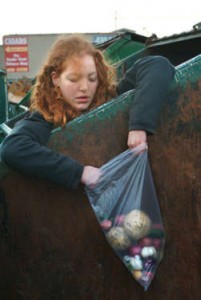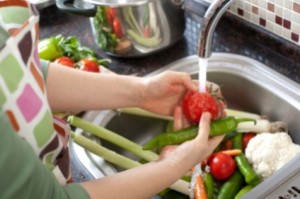 They call themselves freegans: people who live almost entirely on what others throw away, from furniture right down to the food they put in their bodies. Freegans reject the idea of a capitalist system and take pride in their limited participation in a conventional economy.
They call themselves freegans: people who live almost entirely on what others throw away, from furniture right down to the food they put in their bodies. Freegans reject the idea of a capitalist system and take pride in their limited participation in a conventional economy.
According to Freegan.Info, freegans live based on “sharing resources, minimizing the detrimental impact of our consumption and reducing and recovering waste and independence from the profit-driven economy.”
While trash touring or dumpster diving may not sound like reliable methods for sourcing food and nutrition, freegans rarely go hungry, as the Environmental Protection Agency states that Americans dump approximately 38 million tons of garbage daily.
One commenter on a Huffington Post article about a week in the life of a freegan said “While I personally can not see myself dumpster diving, I have seen the waste that restaurants, bakeries and grocery stores discard…it’s good food that can provide meals to the poor or unfortunate.”
However, most freegans are not homeless, or even poor, but rather concerned about the impact of food production and the environment. While some go so far as to eat food exclusively procured from trash receptacles, others try to lean on freegan principles when possible.
“I try to incorporate freeganism into my living as much as I can,” said another Huffington Post commenter. “For example, I’ve found many things I needed around the house from a recycling center I worked in. First come, first serve to everyone and I put these things to good use.”
While freeganism arguably has positive effects on the environment, skeptics wonder if it’s possible to get enough nutrition if you are relying only on discarded or expired items.
“Fresh produce loses much of its nutritional value as it ages,” said Janet Colson, PhD, RD and professor of nutrition and food science at Middle Tennessee University. “A lot of freegan food is over-proccessed and low quality, which give people calories, fat and sugar, but not always the vitamins, minerals and fiber that they need.”
While some freegans report finding plenty of fresh fruits and vegetables during their “trash tours,” Colson said that there is no guarantee that a freegan is getting the nutrition they need.
“It totally depends on the type foods that are available for free,” Colson said. “I have worked at senior citizen centers that received lots of day-old foods from grocery stores, which is similar to what a lot of freegans procure. Some of the free foods were only processed baked goods like white bread, packaged cupcakes and cookies.”
Alternatively, Shari Portnoy, MPH,RD of Food Label Nutrition believes that it is possible to get all your nutrients from a freegan lifestyle.
“Nutrition guidelines are set very high,” Portnoy said. “As a female you only need 1,200 calories of a variety of food to get your nutrients and some people really do throw out a lot.”
 As for whether freegans should be any more concerned about food borne illness than the average person, both Colson and Portnoy agree that the risks are there for anyone, even if you get your groceries from a dumpster.
As for whether freegans should be any more concerned about food borne illness than the average person, both Colson and Portnoy agree that the risks are there for anyone, even if you get your groceries from a dumpster.
“You can get a food borne illness anyway if you don’t keep your food safe,” said Portnoy. “It’s also important as a freegan to use common sense. If it is a hot day, food is more likely to contain bacteria than on a cold day.”
Freegans should also be careful not to “shop” for food that has been out for more than four hours, which makes it more susceptible to bacteria. The “danger zone” is temperatures between 40F-140F.
As far as protection from outside bacteria or external contamination, most items are safe as long as they have been visually inspected for dirt, damage or holes.
“Even food from a garbage dump that is in its original container with no holes or tears is probably safe to consume,” said Colson. “Fresh produce with a rind or peel is a safe bet.”
top image via freegan.info
Also Read:
